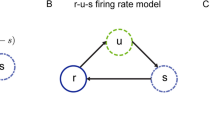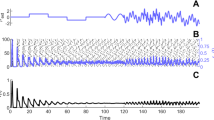Abstract
Firing-rate models describing neural-network activity can be formulated in terms of differential equations for the synaptic drive from neurons. Such models are typically derived from more general models based on Volterra integral equations assuming exponentially decaying temporal coupling kernels describing the coupling of pre- and postsynaptic activities. Here we study models with other choices of temporal coupling kernels. In particular, we investigate the stability properties of constant solutions of two-population Volterra models by studying the equilibrium solutions of the corresponding autonomous dynamical systems, derived using the linear chain trick, by means of the Routh–Hurwitz criterion. In the four investigated synaptic-drive models with identical equilibrium points we find that the choice of temporal coupling kernels significantly affects the equilibrium-point stability properties. A model with an α-function replacing the standard exponentially decaying function in the inhibitory coupling kernel is in most of our examples found to be most prone to instability, while the opposite situation with an α-function describing the excitatory kernel is found to be least prone to instability. The standard model with exponentially decaying coupling kernels is typically found to be an intermediate case. We further find that stability is promoted by increasing the weight of self-inhibition or shortening the time constant of the inhibition.
Similar content being viewed by others
References
Amari S (1977) Dynamics of pattern formation in lateral-inhibition type neural fields. Biol Cybern 27:77–87
Atay FM, Hutt A (2005) Stability and bifurcations in neural fields with finite propagation speed and general connectivity. SIAM J Appl Math 65:644–666
Atay FM, Hutt A (2006) Neural fields with distributed transmission speeds and long-range feedback delays. SIAM J Appl Dyn Syst 5:670–698
Bressloff P (2005) Pattern formation in visual cortex. In: Chow C, Gutkin B, Hansel D, Meunier C, Dalibard J (eds) Methods and models in neurophysics: lecture notes of the Les Houches Summer School 2003. Elsevier, Amsterdam, pp 477–574
Coombes S (2005) Waves, bumps, and patterns in neural field theories. Biol Cybern 93:91–108
Curtu R, Ermentrout B (2004) Pattern formation in a network of excitatory and inhibitory cells with adaptation. SIAM J Appl Dyn Syst 3:191–231
Cushing JM (1977) Integrodifferential equations and delay models in population dynamics, lecture notes in biomathematics. Springer, Heidelberg
Dayan P, Abbott LW (2001) Theoretical neuroscience. MIT Press, Cambridge
Ermentrout GB, Cowan J (1979a) Temporal oscillations in neuronal nets. J Math Biol 7:265–280
Ermentrout GB, Cowan J (1979b) A mathematical theory of visual hallucination patterns. Biol Cybern 34:137–150
Ermentrout GB, Cowan J (1980a) Large scale spatially organized activity in neural nets. SIAM J Appl Math 38:1–21
Ermentrout GB, Cowan J (1980b) Secondary bifurcations in neuronal nets. SIAM J Appl Math 39:323–340
Ermentrout B (1998) Neural networks as spatio-temporal pattern- forming systems. Rep Prog Phys 61:353–430
Hutt A, Bestehorn M, Wennekers T (2003) Pattern formation in intracortical neural fields. Netw Comp Neur Syst 14:351–368
Hutt A, Atay FM (2005) Analysis of nonlocal neural fields for both general and gamma-distributed connectivities. Physica D 203:30–54
Jing ZJ, Lin Z (1993) Qualitative analysis for a mathematical model for AIDS. Acta Mathematicae Appl Sin 9:302–316
Koch C (1999) Biophysics of Computation. Oxford University Press, New York
Laing CR, Longtin A (2003) Dynamics of deterministic and stochastic paired excitatory-inhibitory delayed feedback. Neural Comput 15:2779–2822
Liao X, Wong K, Wu X (2003) Stability of bifurcating periodic solutions for van der Pol equation with continuous distributed delay. Appl Math Comput 146:313–334
Linz P (1985) Analytical and Numerical Methods for Volterra Equations. SIAM, Philadelphia
Murray JD (1993) Mathematical Biology, 2nd edn. Wiley-Interscience, Hoboken
Perko L (2000) Differential equations and dynamical systems, 3rd edn. In: Texts in applied mathematics, vol. 7. Springer, Heidelberg
Pinto DJ, Brumberg JC, Simons DJ, Ermentrout GB (1996) A quantitative population model of whisker barrels: re-examining the Wilson-Cowan equations. J Comput Neurosci 3:247–264
Shen J, Jing ZJ (1993) A new detecting method for conditions of existence of Hopf bifurcation. Acta Math Appl Sin 11:79–93
Tateno T, Harsch A, Robinson HPC (2004) Threshold firing frequency-current relationships of neurons in rat somatosensory cortex: type 1 and type 2 dynamics. J Neurophysiol 92:2283–2294
Tsodyks MV, Skaggs WE, Sejnowski TJ, McNaughton BL (1997) Paradoxical effects of external modulation of interneurons. J Neurosci 17:4382–4388
Vogels TP, Rajan K, Abbott LF (2005) Neural network dynamics. Annu Rev Neurosci 28:357–376
Wilson HR, Cowan JD (1973) A mathematical theory of the functional dynamics of cortical and thalamic nervous tissue. Kybernetik 13:55–80
Wyller J, Blomquist P, Einevoll GT (2007) Turing instability and pattern formation in a two-population neuronal network model. Physica D 225:75–93
Author information
Authors and Affiliations
Corresponding author
Rights and permissions
About this article
Cite this article
Nordbø, Ø., Wyller, J. & Einevoll, G.T. Neural network firing-rate models on integral form. Biol Cybern 97, 195–209 (2007). https://doi.org/10.1007/s00422-007-0167-z
Received:
Accepted:
Published:
Issue Date:
DOI: https://doi.org/10.1007/s00422-007-0167-z




